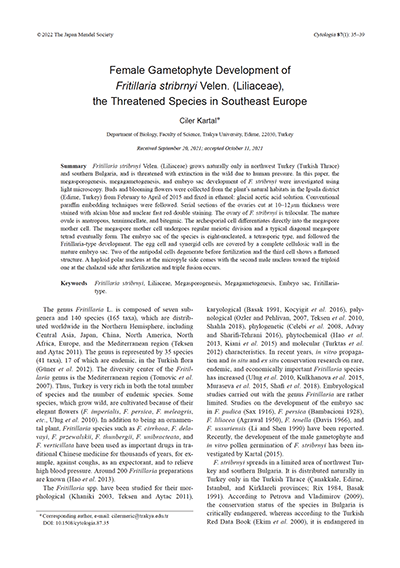NEWS 2022
Female Gametophyte Development of Fritillaria stribrnyi Velen. (Liliaceae), the Threatened Species in Southeast Europe
Ciler KARTAL
Cytologia 86(1): 35-39 (2022)
https://doi.org/10.1508/cytologia.87.35
Department of Biology, Faculty of Science, Trakya University, Edirne, 22030, Turkey
Abstract
Fritillaria stribrnyi Velen. (Liliaceae) grows naturally only in northwest Turkey (Turkish Thrace) and southern Bulgaria and is threatened with extinction in the wild due to human pressure. In this paper, the megasporogenesis, megagametogenesis, and embryo sac development of F. stribrnyi were investigated using light microscopy. Buds and blooming flowers were collected from the plant’s natural habitats in the Ipsala district (Edirne, Turkey) from February to April of 2015 and fixed in ethanol: glacial acetic acid solution. Conventional paraffin embedding techniques were followed. Serial sections of the ovaries cut at 10–12 μm thickness were stained with alcian blue and nuclear fast red double staining. The ovary of F. stribrnyi is trilocular. The mature ovule is anatropous, tenuinucellate, and bitegmic. The archesporial cell differentiates directly into the megaspore mother cell. The megaspore mother cell undergoes regular meiotic division and a typical diagonal megaspore tetrad eventually form. The embryo sac of the species is eight-nucleated, a tetrasporic type, and followed the Fritillaria-type development. The egg cell and synergid cells are covered by a complete ellulosic wall in the mature embryo sac. Two of the antipodal cells degenerate before fertilization and the third cell shows a flattened structure. A haploid polar nucleus at the micropyle side comes with the second male nucleus toward the triploid one at the chalazal side after fertilization and triple fusion occurs. .




